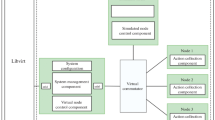Abstract
High-interaction honeypots are relevant to provide rich and useful information obtained from attackers. Honeypots come in different flavors with respect to their interaction potential. A honeypot can be very restrictive, but then only a few interactions can be observed. If a honeypot is very tolerant though, attackers can quickly achieve their goal. Having the best trade-off between attacker freedom and honeypot restrictions is challenging. In this paper, we address the issue of self adaptive honeypots, that can change their behavior and lure attackers into revealing as much information as possible about themselves. The key idea is to leverage game-theoretic concepts for the configuration and reciprocal actions of high-interaction honeypots.
Preview
Unable to display preview. Download preview PDF.
Similar content being viewed by others
References
Cheswick, B.: An evening with Berferd in which a cracker is lured, endured, and studied. In: Proc. Winter USENIX Conference, pp. 163–174 (1992)
Spitzner, L.: Honeypots: Tracking Hackers. Addison-Wesley Longman Publishing Co., Inc., Boston (2002)
Ramsbrock, D., Berthier, R., Cukier, M.: Profiling attacker behavior following SSH compromises. In: DSN 2007: Proceedings of the 37th Annual IEEE/IFIP International Conference on Dependable Systems and Networks, Washington, DC, USA, pp. 119–124. IEEE Computer Society, Los Alamitos (2007)
Alata, E., Nicomette, V., Kaaniche, M., Dacier, M., Herrb, M.: Lessons learned from the deployment of a high-interaction honeypot. In: Sixth European Dependable Computing Conference, EDCC 2006, pp. 39–46 (2006)
Vidal, E., Thollard, F., de la Higuera, C., Casacuberta, F., Carrasco, R.: Probabilistic finite-state machines-part I. IEEE Trans. Pattern Anal. Mach. Intell. 27(7), 1013–1025 (2005)
Mitchell, M., Samuel, A.: Advanced Linux Programming. New Riders Publishing, Thousand Oaks (2001)
Love, R.: Linux Kernel Development, 2nd edn. Novell Press (2005)
Provos, N., Friedl, M., Honeyman, P.: Preventing privilege escalation. In: SSYM 2003: Proceedings of the 12th conference on USENIX Security Symposium, Berkeley, CA, USA, p. 16. USENIX Association (2003)
Greenwald, A.: Matrix games and nash equilibrium, Lecture (2007)
McCarty, B.: The honeynet arms race. IEEE Security and Privacy 1(6), 79–82 (2003)
Bellard, F.: Qemu, a fast and portable dynamic translator. In: ATEC 2005: Proceedings of the annual conference on USENIX Annual Technical Conference, Berkeley, CA, USA, p. 41–46. USENIX Association (2005)
Newham, C., Vossen, J., Albing, C., Vossen, J.: Bash Cookbook: Solutions and Examples for Bash Users. O’Reilly Media, Inc., Sebastopol (2007)
Turocy, T.: Gambit (2007), http://gambit.sourceforge.net/
Dinaburg, A., Royal, P., Sharif, M., Lee, W.: Ether: malware analysis via hardware virtualization extensions. In: CCS 2008: Proceedings of the 15th ACM conference on Computer and communications security, pp. 51–62. ACM, New York (2008)
Garg, N., Grosu, D.: Deception in honeynets: A game-theoretic analysis. In: Information Assurance and Security Workshop, 2007. IAW 2007. IEEE SMC, pp. 107–113 (2007)
Bistarelli, S., Dall’Aglio, M., Peretti, P.: Strategic games on defense trees. In: Dimitrakos, T., Martinelli, F., Ryan, P.Y.A., Schneider, S. (eds.) FAST 2006. LNCS, vol. 4691, pp. 1–15. Springer, Heidelberg (2007)
Sallhammar, K., Helvik, B.E., Knapskog, S.J.: A framework for predicting security and dependability measures in real-time. International Journal of Computer Science and Network Security 7(3) (2007)
Lye, K.W., Wing, J.M.: Game strategies in network security. International Journal of Information Security 4(1), 71–86 (2005)
Nagaraja, S., Anderson, R.: The topology of covert conflict. Technical report, University of Cambridge (2005)
Author information
Authors and Affiliations
Editor information
Editors and Affiliations
Rights and permissions
Copyright information
© 2009 Springer-Verlag Berlin Heidelberg
About this paper
Cite this paper
Wagener, G., State, R., Dulaunoy, A., Engel, T. (2009). Self Adaptive High Interaction Honeypots Driven by Game Theory. In: Guerraoui, R., Petit, F. (eds) Stabilization, Safety, and Security of Distributed Systems. SSS 2009. Lecture Notes in Computer Science, vol 5873. Springer, Berlin, Heidelberg. https://doi.org/10.1007/978-3-642-05118-0_51
Download citation
DOI: https://doi.org/10.1007/978-3-642-05118-0_51
Publisher Name: Springer, Berlin, Heidelberg
Print ISBN: 978-3-642-05117-3
Online ISBN: 978-3-642-05118-0
eBook Packages: Computer ScienceComputer Science (R0)




